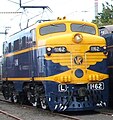Newport Workshops
History
Plans for a workshop at Newport started in the 1860s, to replace the temporary Williamstown Workshops but nothing came of it. It was not until 1880 that work began, when the Victorian Railways purchased annexes used at the 1880 Melbourne Exhibition and erected one of them at Newport, naming it the Newport Carriage Workshops when it began operation in 1882.
Construction of the permanent workshops commenced in 1884, and was completed in 1889. Although the earlier carriage workshop closed at this time, it reopened in 1895 to manufacture signal equipment. The first carriages built by the workshops were completed in 1889, but early locomotives were manufactured by external contractors such as the Phoenix Foundry in Ballarat. The first locomotive built in house at Newport was Z Class 2-4-0T No.526 'Polly 'in 1893. The final locomotive built at the workshops was diesel-hydraulic M Class M232 in 1959.
The main elements of the 1889 workshops are a central stores block and clock tower with offices, the 'East Block' for carriage and wagon works, and 'West Block' for heavy engineering and locomotive building. Expansion followed in 1905–1915, and 1925–1930. During World War II the workshops were turned over to military production, with the rear fuselage, and empennage of Bristol Beaufort bombers being built there.
At the peak of operation it was one of Victoria's largest and best-equipped engineering establishments, with up to 5,000 employees on site. The workshops had its own cricket ground, and in the 1920's the game of Trugo is said to have been invented by workers on their lunch hour. In the late 1980's, the original segments of the workshops were removed from everyday use, with operations continuing at the 1930s complex along the eastern side of the site.
On 15 January 2000, operation of the workshops and ownership of assets passed from the Public Transport Corporation to Evans Deakin Industries (EDI, formerly Clyde Engineering). In March 2001 EDI was taken over by Downer Group to form Downer EDI Rail. Until May 2024, revenue operations were carried out in the eastern section of the workshops by Downer Rail, who carried out work including locomotive and carriage maintenance, and diesel engine, bogie and wheelset overhauls; for customers including Pacific National and V/Line. From 2018 - 2024, High Capacity Metro Trains (HCMT) were constructed at Newport by Evolution Rail in part of the former Boiler Shop. The last HCMT to be constructed was Set 70, which departed for Pakenham East Depot on April 2nd 2024.
Tenants


Since Downer Vacated the site in 2024, V/Line has taken over tenancy of the site for storage and to operate the broad gauge underfloor wheel lathe, one of 3 in Victoria, the others being at Metro Trains Melbourne's Craigieburn and Pakenham East Depots. Most of the former Boiler Shop is leased to Metro Trains Melbourne for maintenance of their Siemens Nexas trains.
The original 1880s workshops have been maintained for heritage uses. The 'West Block' area are occupied by a number of railway preservation groups such as Steamrail Victoria, Diesel Electric Rail Motor Preservation Association Victoria and 707 Operations, while the 'East Block' has been retained by VicTrack for the storage of disused trams, buses and rail rollingstock. The Newport Railway Museum is located south of the operating workshops, near North Williamstown railway station.
In 2009, the surrounds of the former Tarp Shop to the west of the site were developed into train stabling for Metro Trains Melbourne, and are also occupied by Rail Academy Newport.
Gallery
-
R711 at Newport on Steamrail Victoria.
-
R711 on Open day in 2007.
-
D3 658 (D3 639) at Newport In 2007.
-
D3 658 (D3 639) and K190.
See also
References
- ^ "3.4.3 Railway Workshops" (PDF). Hobsons Bay Heritage Study - Volume 1b: Thematic Environmental History. Hobsons Bay City Council. October 2003. Archived from the original (PDF) on 24 May 2009. Retrieved 17 November 2008.
- ^ "ARHS Railway Museum: History 1839 - 1900". ARHS Railway Museum. Archived from the original on 29 September 2009. Retrieved 5 February 2008.
- ^ The Railway Heritage Centre of Victoria (Newport Workshops) Proposal December 1999 Australian Railway Historical Society
- ^ Lee, Robert (2007). The Railways of Victoria 1854-2004. Melbourne University Publishing. p. 166. ISBN 978-0-522-85134-2.
- ^ "Public transport history". Department of Infrastructure. Archived from the original on 20 May 2009. Retrieved 18 February 2008.
- ^ "Works". Newsrail. Vol. 18, no. 9. Vic: ARHS Victoria Division. September 1990. p. 284. ISSN 0310-7477. OCLC 19676396.
- ^ "Miscellaneous" ARHS Bulletin issue 751 May 2000 page 196
- ^ "Newport (Melbourne)". EDI Rail. Retrieved 18 February 2008.
- ^ 1,100 Jobs with 65 New Trains Built in Victoria, For Victoria Premier of Victoria 12 September 2016
- ^ Contact Us 707 Operations
- ^ About Us Australian Railway Historical Society
- ^ Academy, Rail (23 September 2020). "https://railacademy.vic.gov.au/rail-academy-newport/history-of-the-rail-academy-newport". Rail Academy. Retrieved 13 November 2024.
{{cite web}}: External link in|title=
Further reading
- The Newport Story Doenau G Australian Railway Historical Society Bulletin November; December 1979 pages 249-272, 274-288
- Reminiscences of an Apprentice at the Victorian Railways' Newport Workshops 1959-1963 Clark, AJ Australian Railway Historical Society Bulletin, February 1996 pages 35–55
- Experience at Newport Workshops 1941-1946 Whalley, SC Australian Railway Historical Society Bulletin, November 2002 pages 403–406
External links
![]() Media related to Newport Workshops at Wikimedia Commons
Media related to Newport Workshops at Wikimedia Commons



















